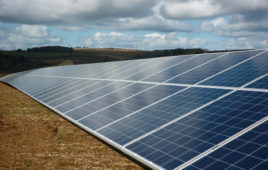Wind and solar account for nearly 10% of U.S. electrical generation in first eight months of 2019
Oct 28, 2019 03:22 PM ET

Renewable energy sources (biomass, geothermal, hydropower, solar, wind) accounted for 18.49% of net domestic electrical generation during the first eight months of 2019, according to a SUN DAY Campaign analysis of just-released data from the U.S. Energy Information Administration (EIA). A year earlier, renewables’ share was 17.95%.
The latest issue of EIA’s “Electric Power Monthly” (with data through August 31, 2019) reveals that solar and wind both showed continued growth. Solar, including small-scale solar PV systems, grew 13.7% compared to the first eight months of 2018 and accounted for a bit more than 2.7% of total electrical output. Small-scale solar — which increased by 19.1% — provided nearly a third (32.6%) of total solar electrical generation. The growth rate of distributed solar was greater than that of any other energy source.
In addition, U.S. wind-generated electricity increased by 4.4%, accounting for 6.94% of all electricity generated.
Combined, wind and solar accounted for almost a tenth (9.64%) of U.S. electrical generation through the end of August. In addition, biomass provided 1.4% (increasing by 2.5%) and geothermal contributed almost 0.4% (reflecting 3.2% growth). In total, non-hydro renewable sources accounted for 11.44% of total U.S. electrical production during the first two-thirds of 2019 and grew by 6.15% compared to the same eight-month period in 2018.
Notwithstanding a 5.2% decrease in hydropower’s output, electrical generation by all renewables (including hydropower) was 1.49% higher than a year earlier. By comparison, nuclear-generated electricity declined by 0.6% while that from coal plummeted by 13.9%. However, much of the latter was replaced by natural gas which grew by 6.5%.
Also read
SOLAR DIRECTORY
Solar Installers, Manufacturers
